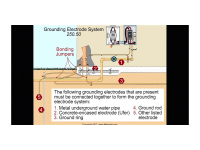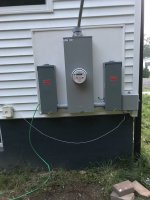Hello everyone, this is my first post here. I am in NJ and completed a whole house rough and finish. I have a 325Amp meter socket with a Square D 150Amp disconnect to either side. The main to the meter socket is 300 MCM Aluminum in 2.5” pvc conduit. The feeders to the disconnects are 4/0 Aluminum. Each disconnect feeds a 40 circuit 150 Amp Square D panel. Panels are located next to each other in Basement 42 feet from disconnects on outside of house. They are connected with 4/0 Aluminum XHHW. My confusion is bonding of everything. I currently have #2 Copper THHN running from Gas pipe to one side of water meter to other side of water meter to 150A subpanel 1 ground bar to 150 subpanel 2 ground bar to disconnect 1 to disconnect 2 to meter socket ground to 5/8” 8’ ground rod 1 to 5/8” 8’ ground rod2. Ground rods located 6’ apart. No bonding screws in subpanels or disconnects. My question is; is my setup correct? Thank you ahead for any responses.
You are using an out of date browser. It may not display this or other websites correctly.
You should upgrade or use an alternative browser.
You should upgrade or use an alternative browser.
Bonding of multiple devices
- Thread starter Glako
- Start date
- Status
- Not open for further replies.
electrofelon
Senior Member
- Location
- Cherry Valley NY, Seattle, WA
- Occupation
- Electrician
No. Your GEC(s) go to your service disconnects, not the sub panels. You're not alone, everyone seems to struggle with grounding of services with multiple enclosures. However it is very clearly spelled out in 250.64 (D).Hello everyone, this is my first post here. I am in NJ and completed a whole house rough and finish. I have a 325Amp meter socket with a Square D 150Amp disconnect to either side. The main to the meter socket is 300 MCM Aluminum in 2.5” pvc conduit. The feeders to the disconnects are 4/0 Aluminum. Each disconnect feeds a 40 circuit 150 Amp Square D panel. Panels are located next to each other in Basement 42 feet from disconnects on outside of house. They are connected with 4/0 Aluminum XHHW. My confusion is bonding of everything. I currently have #2 Copper THHN running from Gas pipe to one side of water meter to other side of water meter to 150A subpanel 1 ground bar to 150 subpanel 2 ground bar to disconnect 1 to disconnect 2 to meter socket ground to 5/8” 8’ ground rod 1 to 5/8” 8’ ground rod2. Ground rods located 6’ apart. No bonding screws in subpanels or disconnects. My question is; is my setup correct? Thank you ahead for any responses.
electrofelon
Senior Member
- Location
- Cherry Valley NY, Seattle, WA
- Occupation
- Electrician
No, looping thru the service disconnects is not one of the options in 250.64(D). Basically you use the tap method, or the common location method. Common location is simplest and if you have a meter base there you might as well do it that way. You can either run two separate grounding electrode conductors, one from the rods and one from the water, or you could run a jumper from the rods to the water and then from the water to the meter base. The gas does not require bonding unless it's CSST where it might be required by the manufacturer.Thank you for your time. So I would run from water meter to each service disconnect then to each ground rod? No connection to meter base? One continuous length of cable.
Although closely related there are distinct differences between "bonding" and "grounding electrode conductors" and you seem to be addre4ssing the latter.
If your POCO allows, it is often easier to have your GEC originate at the meter base.
If not they need to originate at the service panels and not the subpanels.
The diagram may help:

If your POCO allows, it is often easier to have your GEC originate at the meter base.
If not they need to originate at the service panels and not the subpanels.
The diagram may help:

electrofelon
Senior Member
- Location
- Cherry Valley NY, Seattle, WA
- Occupation
- Electrician
Just to expand a little on what Augie said, I think reading thru 250.64(F) will also help you understand a little better. Key takeways are that the GEC is ONLY the thing that goes to you FIRST electrode. After that they are bonding jumpers. Note the busbar provision (3) which is sometimes a nice way to connect together all your electrodes/jumpers and taps.
(F) Installation to Electrode(s). Grounding electrode conductor(s) and bonding jumpers interconnecting grounding electrodes shall be installed in accordance with (1), (2), or (3). The grounding electrode conductor shall be sized for the largest grounding electrode conductor required among all the electrodes connected to it.
(1) The grounding electrode conductor shall be permitted to be run to any convenient grounding electrode available in the grounding electrode system where the other electrode(s), if any, is connected by bonding jumpers that are installed in accordance with 250.53(C).
(2) Grounding electrode conductor(s) shall be permitted to be run to one or more grounding electrode(s) individually.
(3) Bonding jumper(s) from grounding electrode(s) shall be permitted to be connected to an aluminum or copper busbar not less than 6 mm thick × 50 mm wide ( 1 ∕4 in. thick × 2 in wide.) and of sufficient length to accommodate the number of terminations necessary for the installation. The busbar shall be securely fastened and shall be installed in an accessible location. Connections shall be made by a listed connector or by the exothermic welding process. The grounding electrode conductor shall be permitted to be run to the busbar. Where aluminum busbars are used, the installation shall comply with 250.64(A).
(F) Installation to Electrode(s). Grounding electrode conductor(s) and bonding jumpers interconnecting grounding electrodes shall be installed in accordance with (1), (2), or (3). The grounding electrode conductor shall be sized for the largest grounding electrode conductor required among all the electrodes connected to it.
(1) The grounding electrode conductor shall be permitted to be run to any convenient grounding electrode available in the grounding electrode system where the other electrode(s), if any, is connected by bonding jumpers that are installed in accordance with 250.53(C).
(2) Grounding electrode conductor(s) shall be permitted to be run to one or more grounding electrode(s) individually.
(3) Bonding jumper(s) from grounding electrode(s) shall be permitted to be connected to an aluminum or copper busbar not less than 6 mm thick × 50 mm wide ( 1 ∕4 in. thick × 2 in wide.) and of sufficient length to accommodate the number of terminations necessary for the installation. The busbar shall be securely fastened and shall be installed in an accessible location. Connections shall be made by a listed connector or by the exothermic welding process. The grounding electrode conductor shall be permitted to be run to the busbar. Where aluminum busbars are used, the installation shall comply with 250.64(A).
electrofelon
Senior Member
- Location
- Cherry Valley NY, Seattle, WA
- Occupation
- Electrician
You do not need to do any additional bonding for the gas piping. Ask him for a code reference and show him 250.104(B):Local inspector wants gas pipe bonded also.
(B) Other Metal Piping. If installed in or attached to a building or structure, a metal piping system(s), including gas piping, that is likely to become energized shall be bonded to any of the following:
(1) Equipment grounding conductor for the circuit that is likely to energize the piping system
(2) Service equipment enclosure
(3) Grounded conductor at the service
(4) Grounding electrode conductor, if of sufficient size
(5) One or more grounding electrodes used, if the ground‐ ing electrode conductor or bonding jumper to the grounding electrode is of sufficient size
david
Senior Member
- Location
- Pennsylvania
To me the 42 ft inside the house is key to what your asking. Each disconnect feeds a 40 circuit 150 Amp Square D panel. Panels are located next to each other in Basement 42 feet from disconnects on outside of the house
Your panels are grouped and had they been located nearest point of the supply conductors entering the house than the emergency disconnect rules kick in.
You could have made the choice about what location you defined as the service
You made the design choice of installing the distrubution panels 40 some ft from the entry point into the basement and that's perfectly fine.
Electricians need to keep in mind it is a design choice, but the outside emergency disconnect are a requirement.
If you use service entrance cable or ser cable depends on the choice you make in defing what you installed outside
- Status
- Not open for further replies.

